

The law has to be modified to comply with the laws of quantum mechanics and special relativity under the principle of mass-energy equivalence, which states that energy and mass form one conserved quantity. In reality, the conservation of mass only holds approximately and is considered part of a series of assumptions in classical mechanics.

The formulation of this law was of crucial importance in the progress from alchemy to the modern natural science of chemistry. Historically, mass conservation in chemical reactions was primarily demonstrated by Jean Rey (in 1630) and later rediscovered by Antoine Lavoisier in the late 18th century. The concept of mass conservation is widely used in many fields such as chemistry, mechanics, and fluid dynamics. Thus, during any chemical reaction and low-energy thermodynamic processes in an isolated system, the total mass of the reactants, or starting materials, must be equal to the mass of the products. For example, in chemical reactions, the mass of the chemical components before the reaction is equal to the mass of the components after the reaction. The law implies that mass can neither be created nor destroyed, although it may be rearranged in space, or the entities associated with it may be changed in form. Therefore, the quantity of mass is conserved over time. In physics and chemistry, the law of conservation of mass or principle of mass conservation states that for any system closed to all transfers of matter and energy, the mass of the system must remain constant over time, as the system's mass cannot change, so the quantity can neither be added nor be removed.


 0 kommentar(er)
0 kommentar(er)
